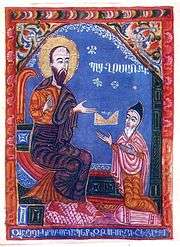Thomas of Metsoph
Thomas of Metsoph (Armenian: Թովմա Մեծոփեցի, Thovma Metsobetsi) (1378–1446) was an Armenian cleric and chronicler who left an account of Timur’s invasions of the Caucasus (1386–1403). What we know of Thomas's life comes from a biography written by his student Kirakos Banaser and from a number of 15th-century colophons.

Biography
Born in Aghiovit, north of Lake Van, Thomas received his early education at the monastery of Metsob, northwest of the city of Arjesh (Erciş in modern Turkey). He had to spend a peripatetic life fleeing the repeated attacks by the Timurid and Turkoman armies. He engaged in teaching and literary activity at several religious centers in Armenian, including Sukhara, Tatev, Lim, and Metsob. He was also involved in the struggle against the influence of Roman Catholicism within the Armenian Church, and helped transfer the Armenian catholicosate from Sis in Cilician Armenia to back to Echmiadzin in Greater Armenia (1441). His major work is The History of Timur and His Successors, which is essentially an eyewitness account written for the most part from memory. Although not flawless, it is an important source for Armenia and Georgia in the late 14th and early 15th centuries. The classical Armenian text was published by K. Shahnazarian in Paris in 1860, translated into French by Félix Nève in 1855, and into English by Robert Bedrosian in 1977.[1]
See also
- Timur's invasions of Georgia
- Turkoman invasions of Georgia
References
- Robert Bedrosian (1987). T'ovma Metsobets'i's History of Tamerlane and His Successors. Armenian Historical Sources of the 5-15th Centuries (Selected Works). Retrieved on January 11, 2008.